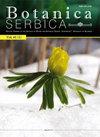抗寒小麦对冷驯化的蛋白质组响应
IF 1.1
4区 生物学
Q4 PLANT SCIENCES
引用次数: 0
摘要
冬季作物在低温驯化和越冬过程中的蛋白质组学分析可为育种工艺设计提供重要信息。本试验旨在研究抗冻冬小麦(cv。利用二维凝胶蛋白组学技术,研究了在寒冷和高海拔地区野外条件下,不同冷驯化期(CA)对北星(Norstar)的影响。结果表明:CA显著提高了玉米的抗冻性,播种后10、14和18周的致死冰冻温度(LT50)均为-28?C, -22 ?C和-10?C,分别。在繁殖期(双脊期)开始时,LT50值显著下降。通过考马斯氏染色在凝胶上区分出约1000个蛋白点。在CA过程中,蛋白质的变化通常发生在那些在光合作用、能量产生(糖酵解)、转录、伴侣样活性、膜和细胞骨架重组、运输、氧化还原调节和信号传导中起功能作用的蛋白质中。结果表明,叶绿体蛋白、某些转录因子如MADS-box转录因子26、抗氧化酶(抗坏血酸过氧化物酶)的表达变化与抗冻性的变化趋势相似,随着生殖生长的开始和抗冻性的丧失,它们的表达减少。在驯化期,大部分变化集中在防御系统和细胞骨架重排上,而光合作用和能量生产则成为生殖生长初期的主要优先事项。本文章由计算机程序翻译,如有差异,请以英文原文为准。
Proteome response of winter-hardy wheat to cold acclimation
The proteome analysis of winter crops during cold acclimation and overwintering can provide important information for designing breeding processes. The current experiment was carried out to investigate the proteome changes in frost-tolerant winter wheat (cv. Norstar) during different cold acclimation (CA) periods under field conditions in a cold and high-altitude region by two-dimensional gel-based proteomic techniques. The results showed that frost tolerance significantly increased by CA and the lethal freezing temperatures (LT50) 10, 14, and 18 weeks after seed sowing were -28?C, -22?C, and -10?C, respectively. By the beginning of the reproductive stage (double ridge stage), the LT50 values had decreased significantly. Around 1000 protein spots were distinguished by Coomassie staining on the gels. The changes in the proteins during the CA often occurred in those with a functional role in photosynthesis, energy production (glycolysis), transcription, chaperone-like activities, membrane and cytoskeleton reorganisation, transport, redox adjustments, and signalling. The results revealed that changes in chloroplast proteins, certain transcription factors such as MADS-box transcription factor 26, and antioxidant enzymes (ascorbate peroxidase) show a similar trend to freezing tolerance, and their expression decreases with the onset of reproductive growth and the loss of freezing tolerance. During the acclimation period, most of the changes were focused on defence systems and cytoskeleton rearrangement, while, photosynthesis, and energy production became the main priority at the beginning of reproductive growth.
求助全文
通过发布文献求助,成功后即可免费获取论文全文。
去求助
来源期刊

Botanica Serbica
Agricultural and Biological Sciences-Plant Science
CiteScore
1.40
自引率
12.50%
发文量
17
审稿时长
34 weeks
期刊介绍:
Botanica Serbica publishes original research papers on all aspects of plant, fungal and microbial biology research including the disciplines of microbiology, mycology, lichenology, bryology, flora, vegetation, biogeography, systematics, taxonomy, plant biotechnology, plant cell biology, plant ecology, environmental plant biology, forestry, genomics, horticulture, limnology, metabolomics, molecular biology, proteomics, virology, plant conservation and protection, and wildlife and ecosystem management.
 求助内容:
求助内容: 应助结果提醒方式:
应助结果提醒方式:


